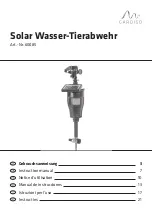
7
WaTer sOfTener disinfeCTiOn
The materials of construction of the modern water softener will
not support bacterial growth nor will these materials contaminate
a water supply. However, the normal conditions existing during
shipping, storage, and installation indicate the advisability of
disinfecting a softener after installation, before the softener is
used to treat potable water. In addition, during normal use a
softener may become fouled with organic matter or in some
cases, with bacteria from the water supply.
Therefore, every softener should be disinfected after instal-
lation, some will require periodic disinfection during their normal
life. Disinfect as follows:
SODIUM HYPOCHLORITE (household bleach)
5.25% SODIUM HYPOCHLORITE solutions are available
under such trade names such as Clorox, Linco, Bo Peep,
White Sail and Eagle Brand Bleach. If stronger solutions
are used, such as those sold for commercial laundries,
adjust the dosage accordingly.
1. Dosage:
a. Polystyrene resin; 1.2 fluid ounce per cubic foot of
mineral (see Capacity & Physical Specifications chart,
page 2).
2. Salt tank:
a. Backwash the softener, and add the required amount
of hypochlorite solution to the brine well of the salt
tank. (The salt tank should have water in it to permit
the solution to be carried into the softener.)
b. Proceed with the normal regeneration.
MisCellaneOus
WaTer sOfTener draininG PrOCedure
In cold weather climates it is common for plumbing systems that
are not in use to be “winterized“ or drained of all water to prevent
any damage that may be caused by the excessive expansion of
water when it freezes. To prevent damage to a water softener it
must be
properly drained also. A simple way to properly drain
or winterize a water softener is to use compressed air to force
all of the water out of the softener mineral tank. The following
procedure will explain the process:
1) Initiate the softener into a manual regeneration cycle, allow
the unit to complete the backwash cycle (this will clean
the media) and start into the brine-draw cycle. Allow the
regeneration to continue in the brine draw cycle until the
brine is drawn out of the salt tank and the air check at the
bottom of the brine pick-up tube shuts off. At this time no
more brine is introduced into the softener and the slow rinse
process begins.
2) Turn the water supply inlet and outlet valves off to the water
softener as soon as the air check shuts off and no more
brine is being drawn into the softener (at the beginning of
the slow rinse process).
3) Unplug the electric power leaving the softener control valve
in the brine draw cycle.
4) Disconnect the brine tube at the top of the salt tank and
force air into the brine tube toward the softener mineral tank
and control valve. The air will force the brine/water solution
that was drawn into the mineral tank out to drain through
the control valve drain line. (An air compressor blow gun
attachment with a portable air compressor works well.)
CAUTION: You do not want to apply any more pressure than
necessary to force the brine/water out of the mineral tank.
The small amount of brine/water that may be left in the
mineral tank will not expand enough to cause any damage
to the softener when it freezes.
If your softener is equipped with an optional bottom drain
on the mineral tank, you will have to follow all of the same
procedures with the exception of the need for compressed
air. With the brine tube disconnected from the salt tank, raise
it to a level above the softener control valve and temporarily
secure it in this position. Now open the drain valve at the
bottom of the mineral tank and allow all brine/water to drain
from the mineral tank.
CAUTION: If a hose is connected to the drain valve to direct
the brine/water to a floor drain be sure it runs downward
and is unobstructed. When brine/water quits running at the
drain, be sure to leave the drain valve open until you start
the system up again.
5) At this time the salt tank has very little water left in it. What
liquid is left is saturated brine, provided that there is still
salt left in the tank. Saturated brine will not freeze solid and
cause any damage and does not have to be drained.
If there is no salt left in the salt tank when the system is
drained we recommend dumping all of the water out of the
brine tank at this time. See cleaning instructions on page
10.
6)
CAUTION: It is important at this time to be assured that
the inlet/outlet water supply piping is properly drained.
Depending on how the water supply piping was routed to
the water softener control valve, a water loop or trap may
have been created.
Sometimes drain valve(s) are installed at the bottom of the
loop to assure all water can be drained out. If not it may be
necessary to disconnect the control valve from the piping
system and open the inlet/outlet valve(s) to allow all the
water to drain from the piping. This should be done when
the rest of the plumbing system is drained.
7) Draining or winterizing of your softener is complete. Refer
to the start-up procedures on page 6 when you are ready
to start your softener.
REMEMBER:
Salt is the fuel to run your water softener.
Buy the best clean salt available.
1. Salt Usage: Use only a processed coarse salt such as pellets
or solar salt.
2. Salt tank Cleaning: It is recommended to periodically clean
the salt tank no matter what kind of salt you are using. To
clean self-contained models, either disassemble the unit
completely or use a wet vacuum to clean it out. See page
10 for cleaning instructions.






































